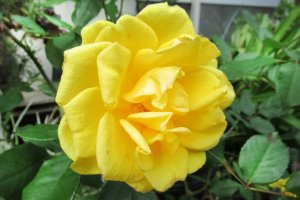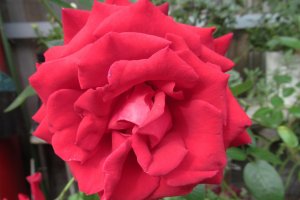In Western countries, the rose is considered the queen of flowers, but I noticed that in Japan the rose is not as popular, and the image of the rose is not found in traditional kamons crests.
History
Wild rose, or nobara in Japanese, has always grown in Japan. The word ibara, which means thorn, is sometimes used to also mean rose. As a garden crop, roses were imported from China in the 12th century, where they were grown for thousands of years. However, in China and Japan, preference was given to lotus, chrysanthemums, camellias and sakura, and roses were used to make rose oil for perfumes.
In the middle of the 18th century, the Chinese rose was imported to Holland and England, and then spread to other European countries, where flower growers worked on them. Interestingly, European varieties of roses, arriving in Japan later, made a splash! The garden rose began to be called bara.

An unreal dream
Roses, as you know, have a very wide palette of colors from cream to dark scarlet. Since there are types of blue colored flowers in nature and in garden flowers, the dream of flower growers was the breeding of a blue rose. Studies showed that roses lack the blue pigment delphinidin, and so the blue rose was considered an unattainable dream.
The first research on the creation of a blue rose began in 1990. The Japanese company SUNTORY, which produces a variety of drinks, teamed up with the Australian floral firm Florigene (currently Suntory Flowers) to conduct gene tests. In 2004, they managed to get closer to the dream - Blue Rose Applause Suntory appeared and was approved for breeding. The color of the rose is not exactly what you can imagine - azure, cobalt or ultramarine, however, if you compare this rose with red, you can see that blue is obviously present in it.

Suntory grows a limited number of its roses, and they are very expensive. Roses of the usual kind are popular as gift bouquets. Currently, the symbolism of the rose color is universal: a white rose is spiritual love, red is passion, yellow is recognition and admiration; red and white roses combined in one bouquet mean harmonious love, and a blue rose is an achievement of the impossible.

Rose Gardens in Japan
Compared to traditional Japanese gardens, there are not that many rose gardens. As a rule, these are European-style gardens. The flowering time of roses is from May to October.
Keisei Rose Horticulture in Chiba was founded in 1959 to create world-class roses and spread rose culture in Japan. The varieties created have won many awards at international competitions.
The park is open from 10-5pm in May, June, October and November. It's closed on Wednesdays. Admission is between JPY500-500 depending on the month.

Kyu Furukawa Garden in Tokyo is open from 9-5pm. Admission is JPY150.
Higashizawa Rose Garden in Yamagata is open 24/7. The nearest station is Murayama Station on the JR Ou Main Line, Yamagata Line.
Hakkeijima Rose Garden in Yokohama is located on the vast grounds of Hakkeijima Sea Paradise Park, is open daily from 10-5pm.
Herb Teien Tabinikki is a rose and herb garden in Yamanashi. It's open daily from 9-530pm. Admission is free.
More rose gardens can be found here.

































